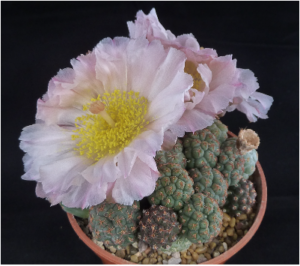Skip to content
Plant of the Month
 Tephrocactus (Puna) bonniae
Tephrocactus (Puna) bonniae
It was a difficult choice to decide what name should be given to this month’s plant
as it has been through a very varied taxonomic journey. It was originally discovered in the
Catamarca Province of Argentina in 1990 and eventually described in 1997 by Dave Ferguson
and Roberto Kiesling, two people well known in the opuntioid field, and assigned to the genus
Punaas Puna bonniae because they recognised several unique features belonging to this
genus separating it for other similar genera.
The species was named after the original finder, Bonnie Brunkow, who recognised the
find as an undescribed cactus. Since then the species has gone through several changes
to the genericname and can be found under Puna, Opuntia, Maihueniopsis and Tephrocactus.
The three species found in the genus Puna were eventually split into three separate genera
between 2001 and 2009 with originally all three being moved to Maihueniopsis then
separated into Tephrocactus (P. bonniae), Maiheuniopsis (P. clavarioides) and Cumulopuntia
(P. subterranean), although further molecular work in 2012 has placed the latter back i
nto Maiheniopsis. Given that Puna species have also been placed variously in Australocy
lindropuntia and Cylindropuntia at times, there may be more to hear about this.
This small-growing plant in habitat is found above 2000m altitude and in cultivation
doesn’t seem to need anything special, except perhaps as much sun as possible.
They seem happy with normal conditions for cacti, a well-drained soil, normal watering in
summer and absolutely dry in winter when they appreciate some cold and can tolerate
some sub-zero temperatures. Buds started to appear at the end of May and take a while
to develop with flowers starting to open at the end of June with the flowers showing at their
best in July. The flowers are exceptional for such a small growing opuntia as you can see
from the photograph, being a very nice delicate pink, and they can reach three inches across.
Whatever the name is, or will be in the future, it is an attractive plant of easy
cultivation and can reward you with an exceptional flower.
 Tephrocactus (Puna) bonniae
Tephrocactus (Puna) bonniae